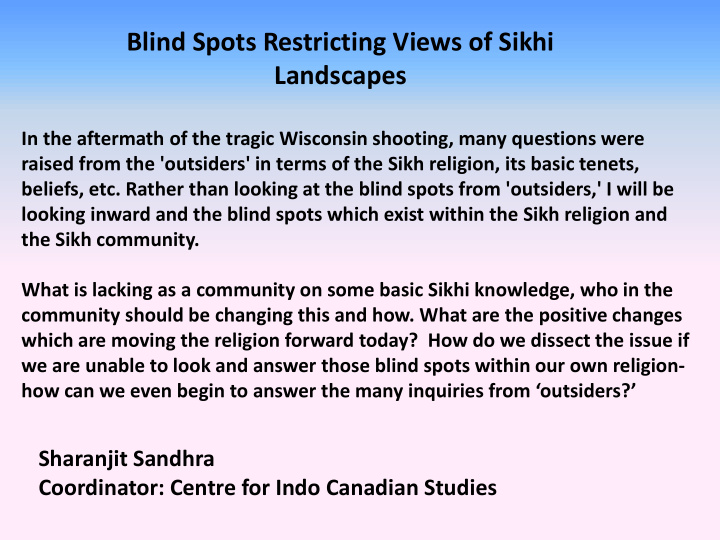



Blind Spots Restricting Views of Sikhi Landscapes In the aftermath of the tragic Wisconsin shooting, many questions were raised from the 'outsiders' in terms of the Sikh religion, its basic tenets, beliefs, etc. Rather than looking at the blind spots from 'outsiders,' I will be looking inward and the blind spots which exist within the Sikh religion and the Sikh community. What is lacking as a community on some basic Sikhi knowledge, who in the community should be changing this and how. What are the positive changes which are moving the religion forward today? How do we dissect the issue if we are unable to look and answer those blind spots within our own religion- how can we even begin to answer the many inquiries from ‘outsiders?’ Sharanjit Sandhra Coordinator: Centre for Indo Canadian Studies
Johari’s Window Johari’s window is a model for helping us think about how we see ourselves and how others see us. It can be useful when exploring equality and diversity, helping us understand the link between private attitudes and public behavior, the value of giving and receiving feedback and the process by which we can change. The success of any community is dependent on how we interact within our community and how we interact with other communities. The Johari window is a powerful lens through which to explore both. This brief experiential session will invite dialogue at both levels. Kim White UFV Conflict Resolution Officer
Blindspots as a physiological metaphor to address philosophic concerns: reflections on Wisconsin 2012 A blindspot is the portion of the retina at the back of the eye where the optic nerve is connected; there are no rods and cones and therefore no light is perceived; it is the point of entry of the optic nerve on the retina, insensitive to light; there is a theory that the other eye compensates visually by filling in what it can't see; some suggest that the opposite eye compensates for the missing visual information; one of the most commonly accepted theories is that the brain actually fills in the missing information using visual cues in the environment. (Merriam Online Dictionary, retrieved September 25, 2012). Looking at this definition, the underlying concerns of: 1. being unable to perceive, being insensitive to one's environment 2. what knowledge/perceptions do we rely on that "compensate" for the lack of clear vision – i.e. what do we "fill in" in place of truth and reality? what discourse and scripts did the shooter and other racists fill in? 3. what visual cues must we attend to if we are to really understand diversity? Awneet Sivia Director, Teacher Education Program
Global Citizenship and Sikh Identity Politics — The Problematics of Community Projection As a brown coloured individual new to the valley, I have often encountered the question regarding my “original” identity. I look like an Indian, although many a time people have asked me if I was Spanish. It hasn’t been easy to establish my racial -ethnic identity in this part of the world that is perceived as an effective multi- cultural model. “So you are a Sikh,” is the deduction that usually follows once the initial queries about me being from India and from Punjab have been addressed. I have often found myself at intellectual, emotional, religious and philosophical cross-roads as I try to respond to this inference. Is the term “Sikh” only to be considered in terms of certain religious markers of which the turban and beard are the most significant ones? And if I don’t wear turban and I shave my beard, can I still claim to be a Sikh? Is there a conflict between the politics of religious markers and the philosophical ideology of Sikhism that wants every Sikh to treat all human beings as children of one God (Manas ki jaat sabhe Eke Pehchanbo)? Has the ideological and philosophical discourse about and within Sikhism taken a backseat owing to an overzealous approach to propagate Sikh identity through religious markers? Whether the incident at Milwaukee happened because of mistaken identity or racial hatred, it does exhort the Sikhs to have a fresh look at the community’s representation and definition of itself. My presentation will focus on some aspects of this definition and representation that are often overlooked in the popular Sikh discourse. Rajnish Dhawan, English Instructor Associate: Centre for Indo Canadian Studies
This short presentation will draw attention to the importance, and limits, of liberal education in preventing incidents such as the Wisconsin gurdwara massacre. A liberal approach to education is an important element of anti-racist human rights discourse, which assumes that tolerance and understanding of diversity are virtues that can be taught. But what happens when individuals and groups cannot access, remove themselves from, or refuse liberal education? Although there are important differentiations to be made among these scenarios, I will suggest that their collective outcomes have similarly reprehensible consequences Nicola Mooney Anthropology Instructor Senior Associate: Centre for Indo Canadian Studies
Laws and Societal Change Anti-racism laws and declarations of human rights are essential components of promoting peace in a multi-cultural democratic society. However, they tend to either work as warnings to persons who do not agree with their intents or they are used to justify penalties after a contradictory act has been committed. The regular reporting of ethnically motivated violence and antagonism towards others are reminders that these pieces of legislation act merely as guideposts as we strive for societal attitudes that reflect genuine equality and respect for everyone we come in contact with. Universities have an obligation and a unique opportunity to be catalysts in the transformation of social attitudes in an effort to make the relevant laws and declarations redundant. Garry Fehr Geography Instructor Director of the Global Development Institute Senior Associate: Centre for Indo Canadian Studies
Recommend
More recommend